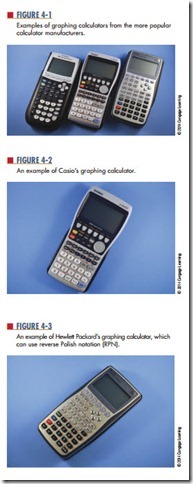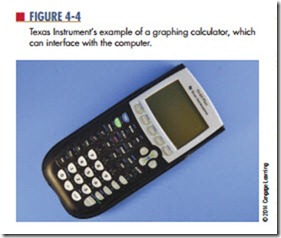Many students have rejoiced that all of their mathematical work can be mastered with a calculator. With just a few keystrokes, a calculator gives the correct answer.
However, some students fail to realize that a calcuxlator is just a tool to perform calculations very quickly, but with no guarantees for a correct answer unless these conditions are met:
● The correct numbers are entered.
● The numbers are entered in the correct order.
● The correct function keys are used at the appropriate time.
Types of Calculators
Graphing calculators and scientific calculators are popular choices when selecting a calculator. Although they are not needed for this textbook, they typically include formulas and functions used in trigonometry, which is the study of triangles and the relationships of the sides and the angles between the sides, and statistics. With these calculators, it is impor- tant to study the manual carefully to be able to use the calculator to its fullest potential.
Graphing calculators are the most powerful and versatile of the calculators. They often are equipped with special features for solving engineering problems. Graphing calculators not only display graphs but are also programmable.
Figure 4-1 shows examples from three of the most popular graphing calculator manufacturers: Casio, Hewlett Packard, and Texas Instruments. Check out more on calculators by visiting the manufacturers’ websites.
Casio has been a successful competitor in many consumer electronics field. Casio offers an array of graphing calculators, such as the example shown in Figure 4-2.
Hewlett-Packard, another popular calculator man- ufacturer, offers some of its calculators with reverse polish notation (rpN) (Figure 4-3).
Texas Instruments offers a variety of models; an example is shown in Figure 4-4. Some of the calcula- tors interface with a computer for downloading and uploading data and come with a calculator-based laboratory.
The criteria for selecting a calculator should include cost, documentation, durability, ease of use, features, and support.
An alternate system commonly used by Hewlett- Packard and some other manufacturers is reverse Polish notation (RPN). RPN is a convenient method to enter formulas as algebraic equations, using the equal key (=) to submit an expression and get an answer.
If you wanted to find out the value of 53 cubed us- ing a standard algebraic notation calculator, it would be entered as follows:
● 53
● yx
● 3
● ENTER
To find the value of 53 cubed using a RPN calcula- tor, it would be entered like this:
● 53
● ENTER
● 3
● yx
The decoders of RPN are often stack based; that is, the operands are pushed onto a stack. Think of the stack as similar to putting plates into one of those spring-loaded, plate-stacking trolleys seen in cafeterias. The plates are removed, used, cleaned, and put back on the trolley. When an operation is performed, the operands are taken from a stack, the mathematical function is performed, and the result is pushed back on the stack, ready for the next operation. The value of the RPN expression is on the top of the stack. Stacks, and therefore RPN, have the advantage of being easy to implement and are very fast.
Scientific calculators are used to solve advanced problems in physics, mathematics, and engineering. They have provisions for handling exponential, trigonometric, and sometimes other special functions in addition to basic arithmetic operations.
Figure 4-5 shows some examples of some of the more popular scientific calculators manufactured. Check out more of these calculators by visiting the manufacturers’ websites.
Whichever calculator you choose, read the owner’s manual thoroughly. Practice with a variety of different problems with known outcomes. Working with a calculator is a great way to review and learn the mathematics of electronics.
Questions
1. What are the two choices of calculators that could be used for electronics?
2. What are the advantages of a graphing calculator?
3. How do the Hewlett Packard graphing calcula- tors differ from other graphing calculators.
4. Describe how to enter a number and operation in an RPN calculator.
5. How does a scientific calculator differ from a basic calculator?

